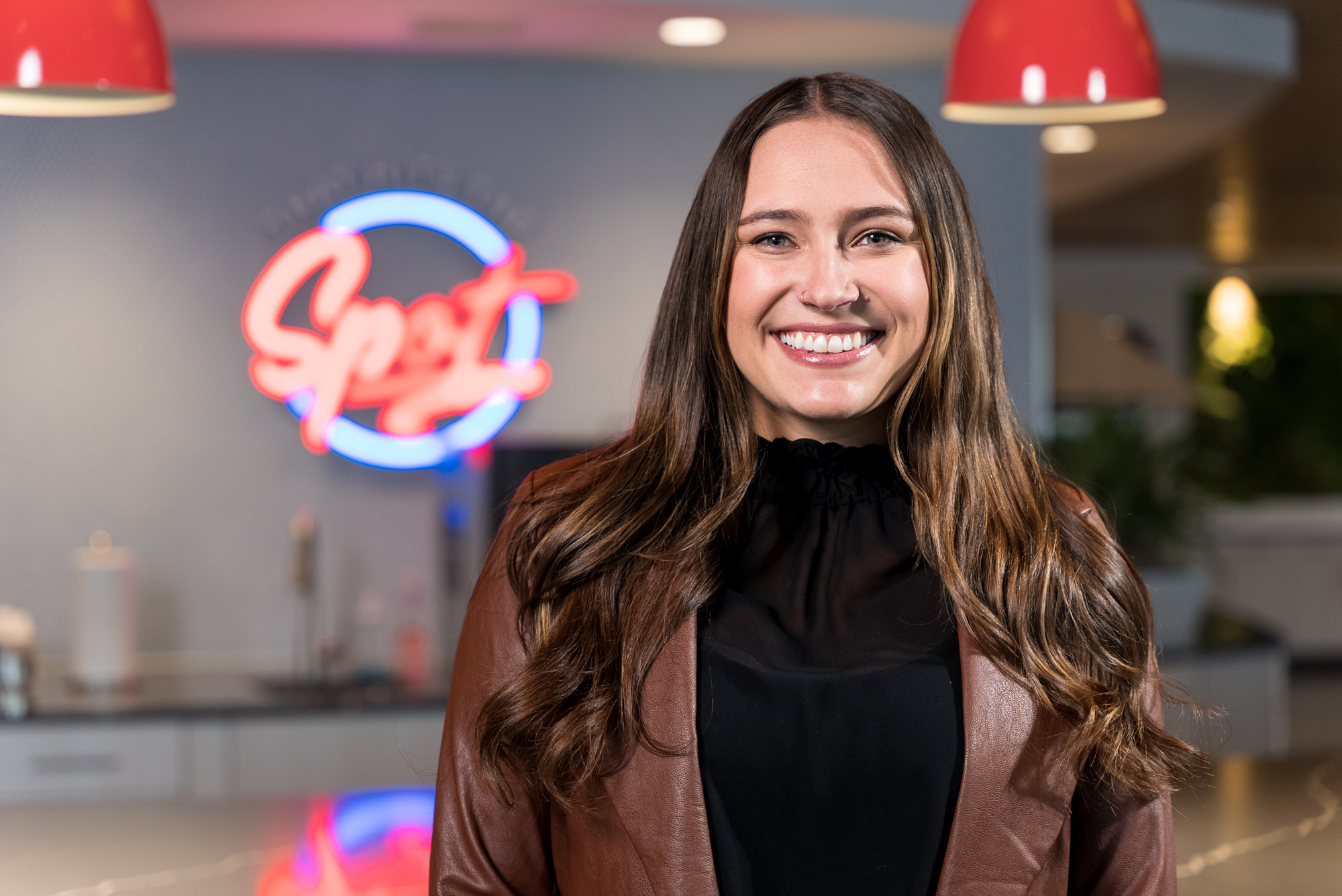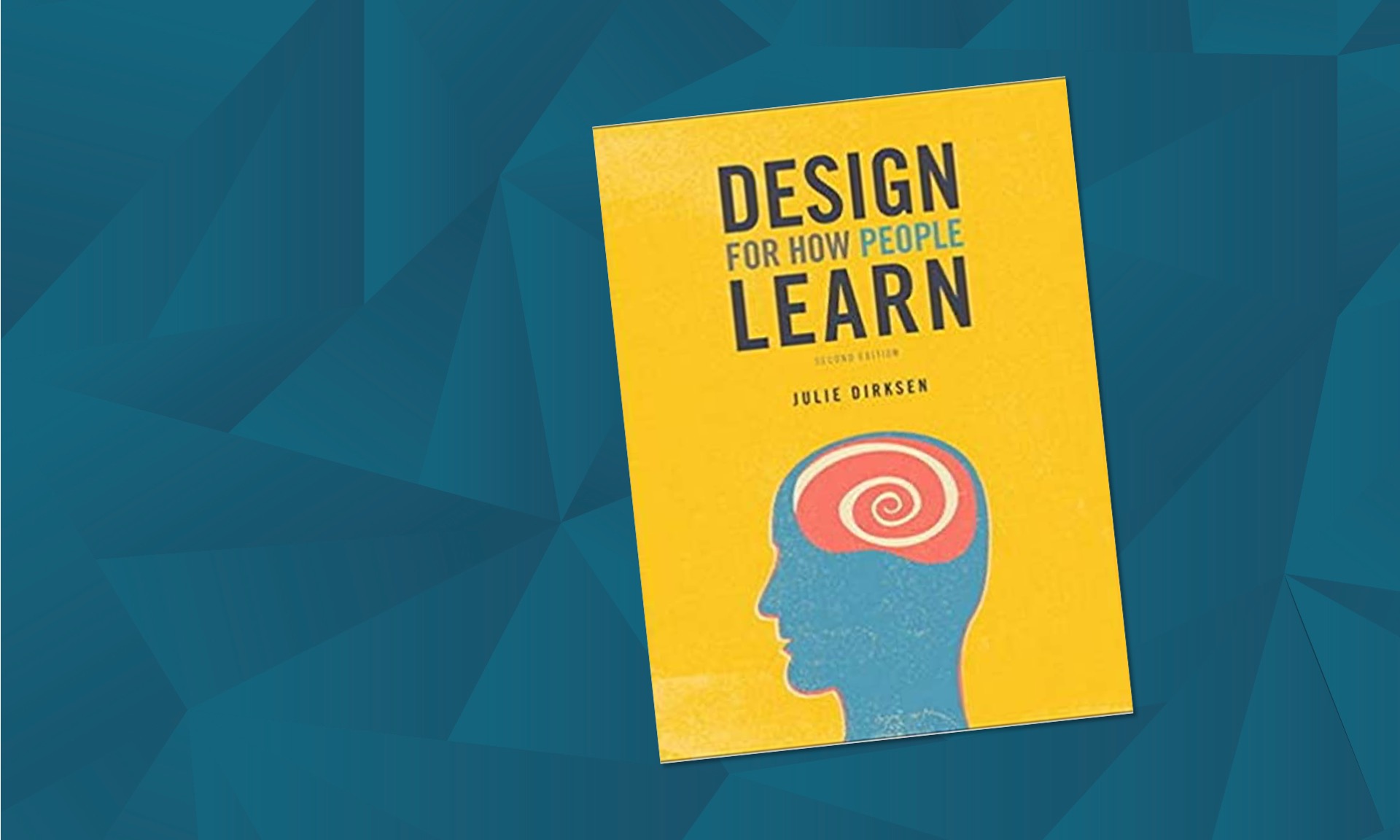Olivia Fuller: Hi, and welcome to Book Club, a Sales Enablement PRO podcast. I’m Olivia Fuller. Sales enablement is a constantly evolving space and we’re here to help professionals stay up to date on the latest trends and best practices, so they can be more effective in their jobs.
Today, I’m so excited to have Julie Dirksen, author of “Design for How People Learn”, join us. Julie, I’d love If you could just take a minute and introduce yourself to our audience.
Julie Dirksen: Yeah, so, my book is “Design for How People Learn” and I identify primarily as an instructional designer. So, how do we design good learning experiences that are effective at helping people basically be better at their jobs?
Almost all of what I do is geared towards kind of adult or workplace learning. “Design for How People Learn” came about because it seemed like we were sort of missing a first book in the field that explained some of the underlying principles to people in terms of how do you think about designing good learning experiences, and what are the factors that you need to take into account? We had some older ones, but there hadn’t been one in a while. And so, my whole marketing plan for the book was hopefully other people will recommend it. And, that’s worked out pretty well. I think we’re somewhere over about 50,000 copies sold at this point.
It was described the target audience as, “Hey, you’re a good customer service rep” or it might be, “Hey, you’re a good salesperson, we’re going to let you train them.” They’re salespeople and then all of a sudden you have to take all of this domain knowledge that you have about your job and figure out how do you communicate it to other people.
And so that’s really who the book is aimed at. And that was my origin story. I was, “Hey, you’re a good data entry person, you can teach data entry to other people.” So, I had a data entry job and I was a college student. So many people come at learning and training and sales enablement from a domain expertise point of view. The whole point was to give people some of the key ideas and background in order to be able to then figure out how do they take all this great knowledge that they haven’t communicated to other people.
OF: In your book, you talk about the importance of assessing different learning gaps when designing a learning experience. What are some of the different types of learning gaps that might be present?
JD: People are always looking for something, have a systematic way to think through a learning problem and to, to decide what to design for it. And that’s where things like learning styles come from like, “Oh, that’d be a way to analyze the problem.” It turns out the evidence base behind learning styles isn’t very good. There doesn’t seem to be much evidence to support that it’s an effective model. I wanted to give people sort of a different tool set and you’ll see a lot of times KSAs are knowledge, skills, attitudes, and I actually expand on that a little bit.
So, I look at if it is a knowledge gap, what’s going to help people. Sometimes that is the gap between where somebody is and where they need to be. If you have a very experienced salesperson who totally knows their product line and all you’ve got are a few updates to that product line, then knowledge is all they need. They just need to know what those updates are. They’ll be able to take that knowledge and go and use it. But if you’ve got an inexperienced salesperson who doesn’t know much about the product line at all, just handing them those facts probably isn’t going to be enough to help them adequately apply those in the workplace.
Sometimes it’s a knowledge gap, but sometimes it’s more than a knowledge gap and a lot of training unfortunately gets treated as we just need to tell people the thing and then they’ll do something differently. I also look at things like procedural gaps, where we have a really defined rule set. So, the procedure for filling out a sales report or the procedures for doing an order or something like that might be really specific. And we have a nice set of rules and we know exactly what correct performance looks like.
But then there are also skills gaps. Skills have one really simple thing. Is it reasonable to think that somebody can be proficient without practice? And if the answer is no. They really can’t be proficient at practice. For example, could you call somebody up and explain it to him over the phone? Well, procedural stuff, maybe you could just talk them through the steps, right?
But with skills, you’re never going to call somebody up and explain golf to them over the phone, and then expect them to be able to go out and play golf. So, anything where we really know that practice is going to be important in order for somebody to get good at something, that’s what I consider to be a skills gap and skills are particularly important because then the answer is sort of built right into the question of what do we need to do for these people?
Well, we need to give them opportunities for practice and figure out how they’re going to get feedback on their performance. I can go as deep as you want on kind of different kinds of skills and what the issues are. A lot of times it’s seeing enough case examples. That’s a big one that shows up in skills gaps, right?
Expertise is often brought about because people have seen enough examples that they start to really understand what the patterns are. But sometimes that stuff is subtle. So, like buying signs from a customer might be something that an experienced person can absolutely pinpoint. Boom, that’s a buying sign.
But if it’s somebody new and they’ve only seen a few customer examples, they may not be able to kind of pinpoint those. The question is how many cases does that new person need to see in order to develop that same level of expertise that your experienced person has?
I also look at gaps around habits, which are things that are it automatic or nearly automatic behaviors that occur in response to usually a trigger in the inbox. So, something you kind of do without thinking about it. You can have knowledge that flossing is a good idea. You can know how to floss adequately. You can even be really motivated the floss. You totally want to start flossing but it’s still not a habit for you. Then when we have that issue of we need that extra mile or ensure whatever the distance would be to make it a habit. Then the question is, how do we do that? Do we build it into procedure? Do we change? Do we make people much more aware of the triggers in the environment and kind of a prediction and how they’re going to handle that trigger so that the habit starts to become a little bit more automatic for people? Do we just practice it enough that they can do it without thinking about it?
There’s a number of different strategies specific to that. If you identify that the gap has habit built into it, then you know there’s some other things that you can do to kind of help with that. Also motivation gaps, and I sort of referred to this as people know what to do, but they still aren’t doing it.
So, people know they’re supposed to wear safety equipment, and yet, for some reason it’s not happening. And then there’s kind of a whole set of questions that you go into with motivation, because quite frankly, we typically think of motivation as people don’t care enough, but usually what the problem is with motivation is that there’s no feedback in the system to reinforce the behavior. Or there’s the other motivation problem – this system is actually set up to reinforce the wrong behavior. I was talking to some people in one of my workshops and they were talking about their company’s different attitudes towards making calls in the car when people were driving.
Both companies actually had a policy against it and one had a policy against it that was followed up on very carefully. And you know, it was a serious infraction if you’re found to be making a bunch of calls while driving. At the other company, it was like, “well, yeah, technically it’s against the rules, but you know, we had to hit your numbers without doing it.”
Everybody just pretends it’s okay. And I’m like, well, you know, the issue there isn’t how motivated this person is to be safe and driving, the issue is, what is it the feedback mechanisms that are in place in both of those environments? Then the last one really is environment. Sometimes it’s easier to fix the system or to fix the tools or to create supports than it is to try to fix the person.
I’ve been using hand washing as an example, and obviously that’s super top of mind for everybody at the moment with pandemics and things like that. But I mean, the hand-washing compliance and health care used to be closer to about 40% and now, and I will grant you it’s been a few years since I pulled the data, but the last time I pulled the data, it was closer to 70%, but the difference was less about changing the people and more about the addition of things like alcohol-based hand rubs and changing the physical environment to make hand-washing super convenient and just part of the process of moving around the physical environments. That’s a case where we can spend a lot of time trying to persuade people to act differently, but actually fixing their environment probably has a bigger impact in that case.
OF: When people have different levels of knowledge, how can you address that with the design of your learning programs?
JD: Yeah, and it really depends. So, if you’re in any kind of environment where the learners are interacting with each other, then figuring out ways to sort of have respect for the people who have more knowledge and then enlist them in the efforts that you’re doing. So, whether it’s group work or having them kind of pairing them up with somebody who’s more of a new person so that they can actually use some of their knowledge and information to help some of the other people in the class. Also, it’s less tedious for them if they’re actually helping people, as opposed to just sort of being told stuff that they already know.
So, this is one of the really hard problems in classroom environments. This is a tough thing, because you want to design your class experience to target the learner where they’re at and when they’re kind of all over the place, it’s hard to have multiple experiences. Especially in kind of face to face classroom and things like that, that in digital environments, I think a lot about is about layering in the environment. So, we’ve got the sort of straightforward version that should be good for everybody, and everybody should be able to understand. But then you can build in some aides and supports for somebody who’s really new. So, I didn’t understand this thing. Tell me more. And you can also build in the learn more or more advanced topics.
And so, creating a good way to sort of set options in front of people so that they can adjust to the level that they want to be at, or that they need to be. I do think that if it’s a good digital learning experience, stuff that you’re asking your learners to do, and so some can access more help or some can speed through it faster, depending on their levels.
So, there are ways to design some of those digital learning environments so that the learners themselves can adapt to it because our computers are still pretty stupid. And the smartest person in a learning environment is still going to be your learner. So. giving them some choices and options that they can choose to see, “yes, I need more information” or “no, I really don’t”. They’re probably the person best able to judge that at any given time. It’s not perfect, but it’s still a better solution. So, trying to figure out how do we create environments where people can adapt the environment themselves, or make choices about how much information they needed at any given point.
OF: What are some strategies to command the attention of your learners?
JD: And this is a hard problem. Honestly, I think this is one of the hardest problems of the big switch that we’ve had to do to virtual learning is when you are in your virtual environments, you’re not leaving your regular workplace and kind of going to a place with less distractions, which is what happens when you go to a training class.
And I mean, there’s other reasons why training classes are maybe less ideal in the sense of they don’t have the context of real life. But at the same time, the fact that you’re sort of stepping out of all of these distractions is a huge benefit. And I think part of the reason that there’s continued to be as much face to face learning experiences as there have been is because it’s definitely cheaper to do digital and not fly people some place. Mostly we can’t right now, so that changes the equation. But I think that the social aspect and the aspect of being able to put yourself outside all of those distractions and things.
So, I think there’s two pieces. One is ensuring that any of your virtual learning experiences are giving people a role, some reason or some active thing to do. So, even if it’s just a Zoom session, can you be asking them questions? Can you have them respond in the chat? Can you have some things that they work on?
Can you use breakout groups? Can you do anything that kind of creates that sort of focus of “I have to do this thing, so that helps me pay attention.” The other piece is there’s certainly strategies that you can encourage people to do about, “Hey, remember to shut off all of your notifications and remember to turn off the ringer on your phone and put it face down.”
Some of those kinds of things, because I know I’ve gotten busted a few times because you’re in a meeting and you know that this part doesn’t apply to you and then you’re checking your email and all of a sudden somebody says your name and you’re like, “I don’t know what we’re talking about.” That’s a very normal part of any kind of online learning environment is how many people are checking their email and things like that.
I’m also a big believer with those kinds of things, it’s not like yelling at people or shaming them, but kind of enlisting them in the solution and the problem-solving. So, what you could do at the beginning of one of those Zoom sessions is go, “okay, what strategies are people using to help them be here and be present and be focused.” And if you even just talk about it and people volunteer strategies, now they have an investment in actually then doing that thing. So, getting people to participate in the conversation of how do we manage those distractions? And then you serve to a certain extent. You just have to accept that. But some of it’s a little bit inevitable. We’re all doing the best we can right now.
OF: What’s the difference between recognizing and then recalling information? And then how can you ensure that retention actually occurs with the information that’s learned?
JD: Absolutely. So, one of the biggest issues with most of the kind of self-study learning environment, so anytime you’ve done any learning course or things like that, it’s relied really heavily on recognition-based learning. So, a multiple-choice test gives you three or four answers and asks you to recognize the right answer.
That’s a much easier cognitive task than being able to just recall the right answer and type it in or something like that. It’s really easy for a lot of those environments to just really rely on recognition. But unfortunately, in the real world, when you’re dealing with a client objection, nobody’s saying, which of these three choices would you like to respond to this client with?
That’s not how that goes, sadly. You don’t have the Google glass thing that gives you your little choices right up there here. Which option would you like to say to this customer? We may get there eventually, but we don’t have it right now, in most cases.
If people have only learned to that standard where they can pick it out of a list, which is recognition, then they may not be able to actually recall it and be able to use that answer when they go back out into the field and they’re talking to somebody. In order to get them to that recall standard, where they can actually generate the answer for somebody, they probably need to practice actually doing that.
Now, one of the nice things about digital tools is there are a lot of ways for people to like record themselves or things like that. So, I know that there are a number of webcam-based sales simulation things that are out there in the world. Those can be really nice. I like the ones where people actually have to come up with their own answer as opposed to just choosing one from a set of options and choosing one from a set of options can be a great way to learn it in the first place, but it probably won’t get you to the point where you can actually then recall that answer when you’re talking to the customers.
So, the question is how do we get the practice to the point where people can actually remember this answer and use it when they get out into the world, as opposed to just being able to choose it from a list.
OF: How can learning design help turn skills into habits?
JD: Yeah. So, one of my favorite sort of little tools or tricks is something called the implementation intentions. And what implementation intentions are, this is a researcher named Peter Gollwitzer. Who’s done a lot of work in this area. And what he’s looked at is basically just setting up a little script for yourself when X happens, I’ll do Y. And so basically, we know that we’re going to get certain responses back.
So, let’s say we’re in a sales call. We know we’re going to get certain objections. I think with objections, there’s pretty good stuff around when you get this objection, here’s what your plan is. But you think about it in terms of all of these sort of little triggers that exist out in the world.
So, I’ll give you an example of what an implementation intention might look like. Let’s say you want to quit smoking and you know that you’re going to get cravings to smoke at some point. So, you can create an implementation intention that says, “okay, when I feel that craving what I’m going to do, I’m going to distract myself”. And that one’s okay.
But you can actually get more specific. So, you could say if I get a craving to smoke, because I’m stressed out, I’ll call my sister and my sister will talk me down. Or if I get a craving to smoke because I’m bored, I’ll play Candy Crush on my phone. Or if I get a craving to smoke because I’m around other people and it’s socializing, I’ll chew gum. I’m just going to have my plan ready because typically we run into these situations where we’re trying to formulate a new habit.
We don’t really know exactly how we want to respond to it. We know we want to do it, but we don’t necessarily, they have like the little script written in the back of her head because it’s much easier to execute if you’ve already decided on what the action is when you bump into this thing.
So, if I hear this objection, I’m going to ask this question. Or if I bump into this problem, I’m going to do this thing. It’s a really tiny thing, but it’s actually kind of a nice life hack for stuff. I have a standing implementation intention that when I can’t find something in my house, so let’s say I can’t find the key the garage door or something like that, when I do find it eventually, I will put it back in the first place that I looked for it when I started looking for it, because that’s apparently where my brain thinks it belongs. And so instead of putting it back where I found it, I’m going to put it back where I think it should be.
And then that way, things are easier to find after the next time I need the key to the garage door lock or something like that. So, having those little things can be a really nice strategy around habits.
OF: Well, Julie, thank you again for sharing your expertise here with our audience. We really enjoyed the conversation.
JD: Yeah, no problem, absolutely.
OF: To our audience. Thanks for listening. For more insights, tips, and expertise from sales enablement leaders, visit salesenablement.pro. If there’s something you’d like to share or a topic you’d like to learn more about, please let us know. We’d love to hear from you.




